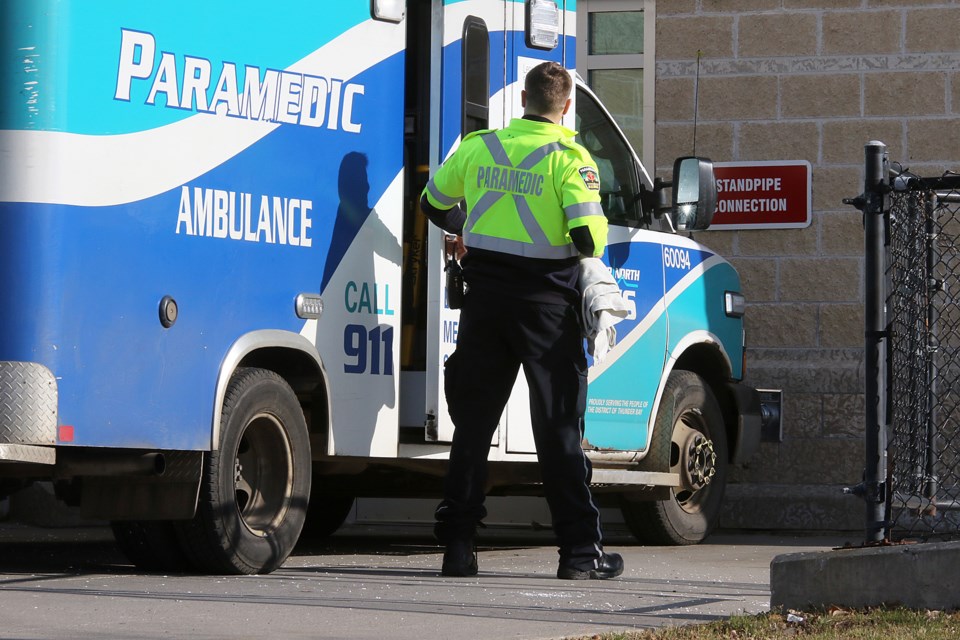THUNDER BAY — A report shows the Thunder Bay district’s paramedic service is feeling the squeeze of rising call volumes, even as the agency launches new strategies to confront those issues.
Superior North EMS chief Shane Muir provided an overview of the service’s plans to confront daunting challenges to Thunder Bay’s city council last week, delivering an implementation update on the EMS master plan.
Council approved the 10-year plan in 2021. While Superior North EMS serves 14 municipalities, First Nations, and unorganized areas across the district, the city has exclusive authority over its operations.
Muir’s update to council highlighted forces straining the agency: an aging population, rising call volumes, a worsening opioid crisis, ballooning offload delays at the regional hospital, and growing issues with recruitment and retention.
Calls on the rise
Emergency calls to EMS have spiked by over 30 per cent since 2016, topping 43,000 calls last year.
Call volumes had already increased by 80 per cent from 2005 to 2015, despite stagnant population levels.
The most serious calls, Codes 3 and 4, have remained flat during that time, however, with lower-acuity calls – often relating to mental health and addictions – driving the increase.
While around 69 per cent of emergency calls are dispatched as Code 4 Urgent, requiring lights and sirens, only four per cent are actually deemed Code 4s after paramedic assessment, Muir said.
Response times up
The report showed the service is struggling to meet Ministry of Health response time targets for the most serious calls.
The service met its six-minute response target for the most acute calls under the Canadian Triage and Acuity Scale just 59 per cent of the time.
While that falls just one point shy of the 60 per cent success rate Superior North EMS targets, Muir called it a trend that needs reining in.
“It is concerning, because … we do need to respond to those calls in a timely manner. So we want to create more capacity in our health care system so we can respond to those type of calls.”
Muir noted the data covers service across the district, where larger distances cause challenges.
He added EMS is tentatively on track to meet its response time targets this year.
He's also hopeful a switch to the new Medical Priority Dispatch System (MPDS), slated to go live in January 2024, will also help the service better prioritize more medically acute calls.
He called the previous DPCI II system “archaic,” saying it tends to overprioritize calls.
“As we've seen this rising increase in call volume, the system's just become unsustainable and we don't have enough paramedics, we don't have enough ambulances or resources to send all these units out in that priority nature at the frequency,” he said.
The switch could result in longer ambulance waits for those calling with less serious issues.
Offload delays
Offload delays at the Thunder Bay Regional Health Sciences Centre continue to put major strain on the service.
Ambulances spent over 15,000 hours in offload time at the hospital last year, ballooning from 2,752 hours in 2016.
The 90th percentile offload time was at nearly two hours, up from around 17 minutes in 2016, while paramedics say waits of four or six hours are not uncommon.
“It does cause significant pressures on us, because we can't get out to respond to the rest of the calls that are happening in the community,” said Muir.
“[Paramedics] are not getting their lunch breaks, they're not getting home on time and those kinds of issues just compound into poor workplace mental health, more burnout. It's something that's compounding all the issues together to the perfect storm.”
The EMS service has stated its desire to see the hospital implement the “Fit to Sit” approach, which aims to transfer lower-acuity patients more quickly and has been implemented in Sudbury.
In an interview, Muir said while that process hasn’t been formalized, the agency continues to work with the hospital on offload delays and has identified possible strategies including expanding offload delay nurse hours.
Safe sobering site needed
Municipal and health leaders have been calling on the provincial government for years to fund programs like safe sobering sites to take pressure off of the overstretched hospital system.
The lack of those services was highlighted in a 2022 coroner’s inquest into the deaths of Don Mamakwa and Roland McKay while in Thunder Bay police custody.
The jury recommended the province work with local health agencies to establish a sobering centre with an “alternate level of care” designation that would allow paramedics and police to bring people there rather than the hospital.
Muir said a sobering centre is “desperately needed,” adding the city’s existing detox facility is constantly full.
“I believe an alternate destination for ambulance and police transport should be a top priority for the city,” he said. “It would decrease the burden on the emergency department, it would mitigate some of our offload delays, it would help paramedics get back on the road so they can service those high priority calls.”
The EMS chief told council the cancellation of the Street Outreach Service (SOS) program has also been felt in increased calls related to mental health, homelessness, and addictions.
“It’s been a big gap since we lost SOS,” he said. “It’s something we can see having a huge impact for our paramedics and their wellbeing as well.
He added Superior North EMS has applied to the Ministry of Health to fund a mobile response program that would meet some of the same needs, employing a mental health worker.
